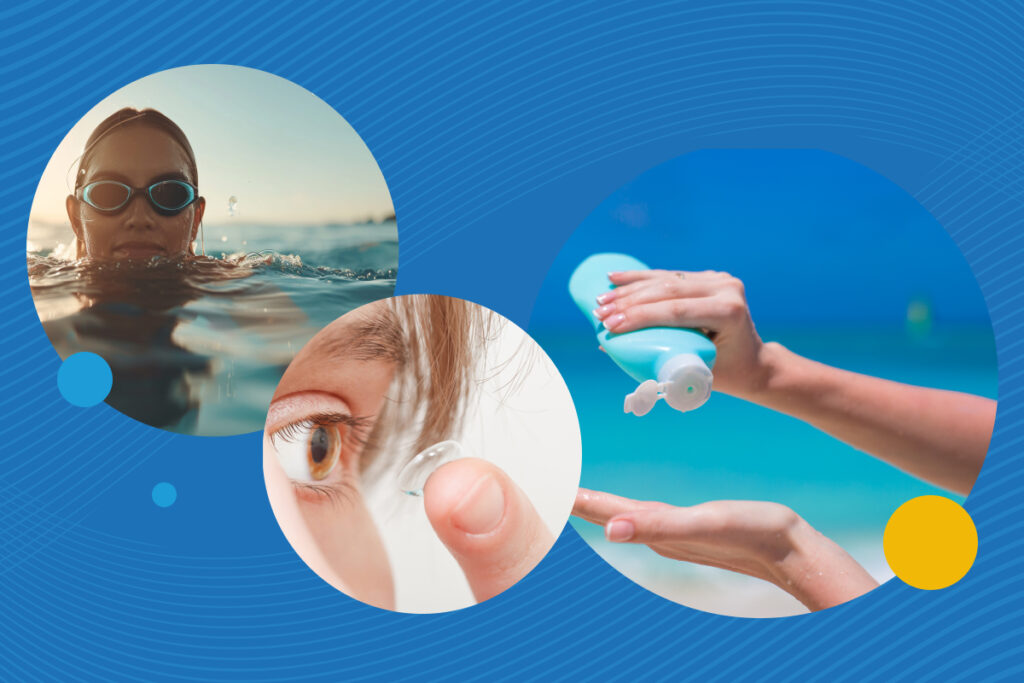Sweat, sunscreen, and swimming can all affect how comfortable and safe it is to wear contact lenses during the summer. While contacts offer freedom from glasses and flexibility for outdoor activities, warmer weather brings its own set of challenges. With a few simple precautions, you can keep your eyes healthy and your vision clear all summer long.
Do: Keep Your Eyes Hydrated
Summer heat, outdoor exposure, and dry indoor environments from air conditioning can all contribute to dry, irritated eyes, especially for contact lens wearers. Staying well-hydrated and using lubricating eye drops can help maintain comfort throughout the day.
Eye drops like SYSTANE COMPLETE Preservative-Free are a great option for regular use. They’re designed to provide lasting hydration and comfort, and since they’re preservative-free, they’re gentler on sensitive eyes—ideal for contact lens users dealing with dryness in hot or windy conditions. If you often find your lenses uncomfortable after time outside, incorporating a high-quality drop into your routine can make a big difference.
Don’t: Swim with Your Contacts In
Even though it might seem harmless, swimming with contact lenses—whether in pools, lakes, or the ocean—can significantly raise your risk of serious eye infections. Water can introduce bacteria and microorganisms that get trapped under your lenses, leading to conditions like Acanthamoeba keratitis, which can be difficult to treat.
To protect your eyes, remove your lenses before getting in the water. If you need vision correction while swimming, ask your optometrist about prescription swim goggles or consider daily disposable lenses you can discard immediately afterward.
Do: Consider Daily Disposables for Travel and Outdoor Adventures
Summer often means vacations, weekend camping, or long days away from home. Daily disposable contact lenses are a great option for these occasions. They’re low-maintenance, don’t require cleaning or storage, and reduce the risk of infection since you use a fresh pair each day.
For people who spend a lot of time outdoors, daily lenses also help avoid the buildup of dust, pollen, and sweat that can happen with longer-wear lenses. They’re especially convenient if you’re in unpredictable environments or can’t always wash your hands thoroughly before handling your lenses.
Don’t: Get Sunscreen in Your Eyes
Sunscreen is essential for skin protection, but it can be a problem if it gets into your eyes, especially when you’re wearing contacts. Certain ingredients in sunscreen can cause stinging, watering, or blurry vision. Applying sunscreen too close to your eyes or rubbing your face while sweating can increase the chance of it migrating into your eyes.
Choose a mineral-based or fragrance-free formula and apply it carefully around (not directly on) the eye area. If sunscreen does get into your eyes, remove your contacts and rinse with preservative-free artificial tears or sterile saline. Wait until your eyes feel normal again before reinserting lenses.
Do: Wear Sunglasses with Full UV Protection
Even if your contact lenses offer some UV protection, they don’t cover the entire eye or surrounding skin. Wearing sunglasses that block 100% of UVA and UVB rays helps reduce your risk of long-term eye damage like cataracts and macular degeneration.
Wraparound sunglasses or those with close-fitting frames offer better protection by blocking light from the sides. Combining contacts with sunglasses is an effective way to enjoy clear vision and eye safety outdoors.
Don’t: Ignore Signs of Discomfort
Summer allergens, dust, and sweat can all contribute to lens discomfort. If you notice persistent redness, blurry vision, or sensitivity to light, it’s best not to ignore it. Removing your lenses and giving your eyes a rest can prevent a minor irritation from turning into something more serious.
If discomfort continues even after switching to fresh lenses or using eye drops, schedule an eye exam to rule out dryness or other underlying issues. It’s always better to catch problems early, especially if you wear contacts regularly.

